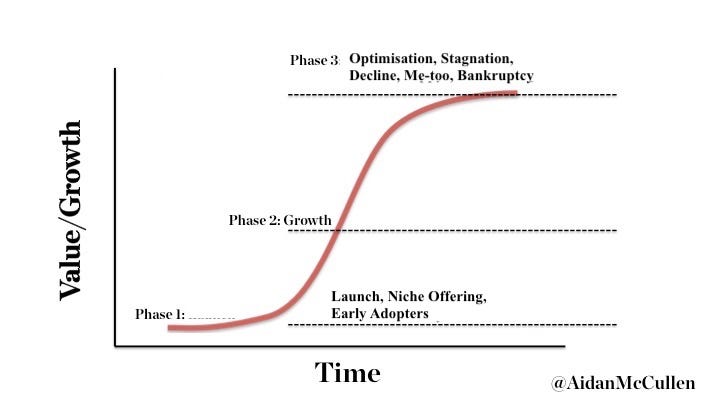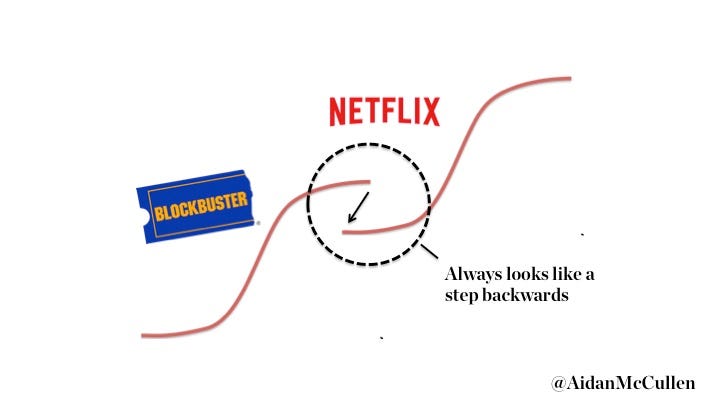
Cognitive dissonance is the mental discomfort (psychological stress) experienced when we simultaneously hold two or more contradictory beliefs, concepts, or values. The occurrence of cognitive dissonance is a consequence of a person performing an action that contradicts personal beliefs, ideas, and values; and also occurs when confronted with new information that contradicts said beliefs, concepts, and values.
Many CEOs and leaders experience cognitive dissonance when they are aware they are managing a business while many competitors or startups are operating a newer version of their business. Often this newer version is built for the needs of the customer of today, while the older business knows their business is a melting iceberg.
Business leaders deal with this in various ways. Some choose to ignore the inconvenient truth. Some launch sheep-dip innovation projects to appease the board and shareholders. The few that accept the challenge realise that they need to change the business operating system. They cannot throw the baby out with the bathwater; after all, the business of today is making money and is well established.
The dilemma arises: how do we manage the business of today while implementing a new operating system for the business of tomorrow?
Brains, Habits and Switch Costs
Our brains are constantly seeking ways to conserve energy. To do this the brain looks for shortcuts. Routine shortcuts include punching in your phone password or setting the alarm at night or simply locking your door.
You know when someone asks you “Did you put the alarm on?”, you sometimes can’t remember, but you can automate it when you need to. Oftentimes, you need to avoid thinking about a pin number in order to remember it. This is your brain at work saving you precious energy.
Almost 50% of what we do every day is driven by habit, many things we do, we do on autopilot.
Our brains love status quo. Any attempt to make meaningful change causes psychological stress or cognitive dissonance. This stress is not anecdotal, it is visible on brain scans.
When it comes to change, our brain is trying to reconcile two things: the desired change and the status quo. To succeed we must overcome psychological discomfort.
Our brain’s default response is always to go back to what it was doing, to continue our habitual behaviour. This is the status quo the brain loves.
The challenge arises, how do we rise above the fear and beat the desired status quo?
Switch Costs
Switch costs are generally associated with moving from one product or supplier to another. Think for example if you were to change telecoms suppliers and the switch costs involved. Switch costs come in the form of cancellation fees, lack of familiarity or learning a new product or service.
Just as there is a cost to change suppliers, there are also costs involved in changing from one mindset to another.
For our brains, switch cost comes in the form of fear, uncertainty and lack of familiarity. Our brains do not like these things and our inner voice does everything to convince us it is not worth changing. This is why it is often hard to develop positive habits such as going to the gym or adopting a new diet.
We have to go beyond the discipline of change and have a meaning to power the change. That can come in the case of a burning platform such as a health diagnosis or it can come from a proactive choice where you want to be a positive role model for your children.
Just as there are switch costs in life, there are switch costs in the business world.
Corporate Leadership Brains
Business leaders facing disruption are very familiar with cognitive dissonance and switch costs. Like we often do in our personal lives, leaders can find ways to quieten the desire for change.
In life, many people use substances such as alcohol to mask their discomfort with their current reality.
In business, leaders mask change with high-velocity activity. Being busy “doing things” is easier than questioning why we are doing them.
Planning and execution are often confused with strategy. Creating a strategy involves addressing cognitive dissonance and weighing up switch costs.
S Curves
S curves are a great way to map both business and product lifecycles. S curves can be used to map how a business can manage the migration from one business model to another.
S curves follow the shape of the letter S with a shallow start with early adopters and niche clientele. Rapid growth comes next, followed by a dominant position in the market.

After the rapid growth, businesses or products plateau and experience stagnation, process optimisation, automation, job cuts and quite often a me-too proposition.
To innovate, companies and leaders need to jump from one S curve to another, but few have the courage to do so. The jump always looks like a step backwards.The jump involves overcoming switch costs and embracing cognitive dissonance.


When Blockbuster CEO, Jim Keyes took over he ignored the next jump for Blockbuster, which was a Netflix model. When quizzed over why he turned down the option to acquire Netflix (for under 1 million) he stated: “Neither RedBox nor Netflix are even on the radar screen in terms of competition”. Not long after Blockbuster went bankrupt and we know the success story Netflix is today.
From Keyes perspective, he was doing a good job focussing on what Blockbuster did well today. For him and his team, looking at the next jump (which always looks like a step back) was a distraction.

You can see the same pattern appear when we consider changing our habits.

From a business perspective, jumping the curve is a challenge. From a brain perspective, it is no different, we must face the challenges.

Embracing Contradictions, Becoming Split Brained?
What if instead of a jump to a new curve, the curves existed on the same continuum? This would mean embracing cognitive dissonance. This would mean managing the existing curve while nurturing the new curve (ideally new curves).
The answer for so many corporations has been to create an innovation team, away from the company, with a new culture, with a new “way of thinking”. Sheep-dip innovation initiatives aside, in spite of great intentions by leadership, the innovation team often becomes their own silo. Imagining the corporation brain for a moment, this is akin to a new idea and as we know new ideas get rejected.
“The human mind treats a new idea the way the body treats a strange protein, it rejects it.” — P.D. Medawar (Biologist)
We have examined corporate activities and brain activities in tandem. This highlights that to truly change how a corporation operates we need to change how a corporation thinks.
To move beyond corporate cognitive dissonance, we could embrace it instead. We could embrace a new competing business model alongside an existing one. To avoid vested interest protectionism, such new models could target a new business segment. To avoid prematurely shutting down initiatives, new models must have new rules and not be stricken by high expectations of quarterly or yearly sales. This is why startups succeed with new models where established businesses fail, the expectations are less and the runway is longer. To succeed here a corporate must embrace a contradiction be the incumbent or established business with high sales expectations on existing products while nurturing a new product with minimal sales expectations.
Recalling that cognitive dissonance is the mental discomfort (psychological stress) experienced when we simultaneously hold two or more contradictory beliefs, concepts, or values. Corporate leadership must then become split-brained. It is important to note that the brain is not a series of brains, but a split one to avoid the dominant brain outmuscling the other.
If leadership masters split-brained leadership they can switch from one mode of thinking to another as the need arises.
Piano Leadership Lessons
Our brilliant guest on this week’s innovation show is Dr Srini Pillay and I love his explanation of managing contradictions in his excellent book ‘Think Less Learn More: Unlock the power of the unfocused mind’.
When you play the piano, you learn to play parts for the left and right hand, and the patterns of movements for each hand often differ. When you’re playing a piece that uses both hands, you can’t focus on one hand at a time. You have to focus on both. To do this, your brain unfocuses — deactivates — and your attention deepens as you let go of your focus on each individual hand, especially if you’re playing a concerto as opposed to something simple like musical scales. Focusing on one task at a time is called serial processing. Serial processing makes bottlenecks worse. Instead, you should unfocus. By activating parallel brain circuits and deactivating focus, you allow your brain to share the energy it has to attend to both hands, making supertasking possible.
The paragraph above encapsulates the concept of embracing of being split-brained. One hand needs to be capable of playing independently of the other. However, for true mastery and to create work of art, both hands need to be able to play in concert. By mastering two or more business operating systems at once, leaders can master true disruptive innovation. This is leadership, not management.
The excerpt below is from “If” by Rudyard Kipling and explains the phenomenon of embracing contradictions extremely well.
“If you can dream — and not make dreams your master;
If you can think — and not make thoughts your aim;
If you can meet with Triumph and Disaster
And treat those two impostors just the same”
Dr Srini Pillay is this week’s guest on the innovation show. Srini is CEO of Neurobusiness group and part-time assistant professor of psychiatry at Harvard Medical School. He is Author of ‘Think Less Learn More: Unlock the power of the unfocused mind’.
In this fantastic chat, we discuss how individuals can harness their inner creativity through a series of easy to do daily rituals. Dr Pillay shares some of the tools he had developed to unleash our innovation.
We discuss how and why individuals can become more innovative, more creative, happier and less stressed.
We discuss how corporations can embrace the true diversity of thought.
We discuss how leaders can harness vision to create better organisations.
We discuss the mindset behind the law of attraction and why it works when done properly.
As always, the show is broadcast on RTÉ Radio 1 extra 3 times weekly and is on iTunes, TuneIn Stitcher Player FM and Google play. The website is here. Soundcloud is embedded below: